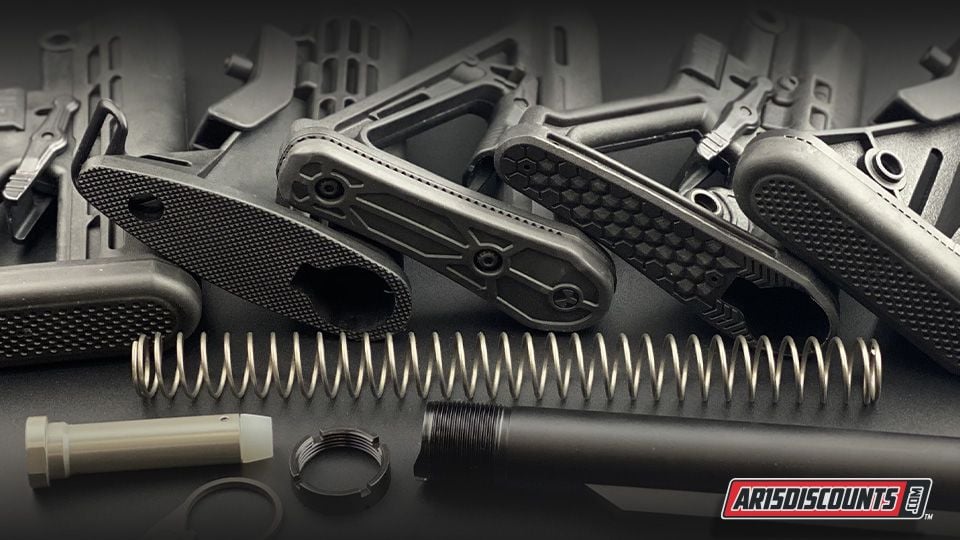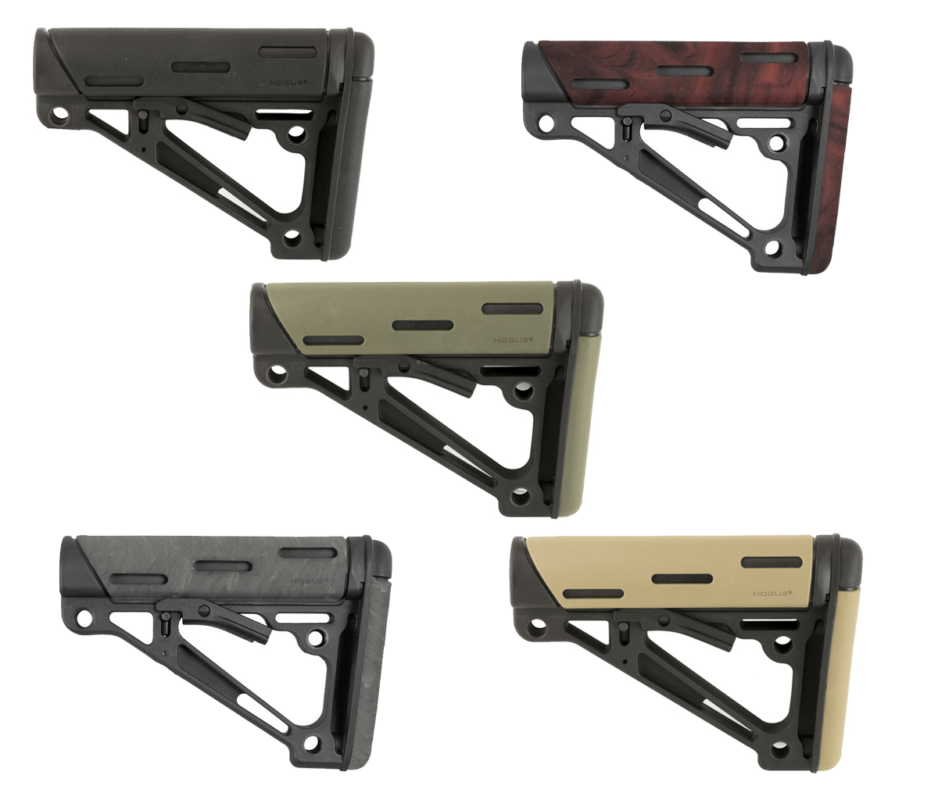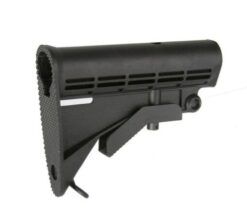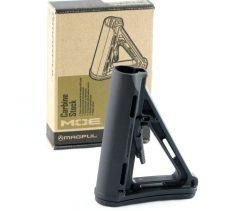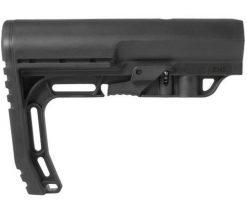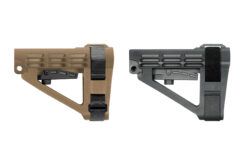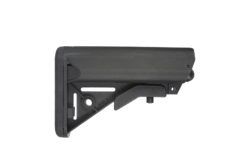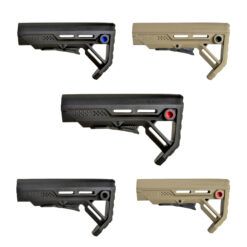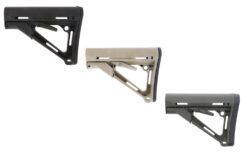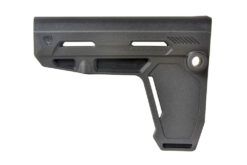AR-15 Parts
Types of AR-15 Stocks and Their Uses
Table of contents
- Understanding the Role of the AR-15 Stock
- Main Types of AR-15 Stocks
- Choosing Between Fixed and Collapsible AR-15 Stocks
- Specialized Stock Types: Precision, Minimalist, Folding & Pistol Brace
- How AR-15 Stock Choice Affects Fit, Accuracy & Comfort
- Compatibility & Installation Tips
- Frequently Asked Questions
When building or upgrading your AR platform, choosing the right AR-15 stock is a critical decision. The stock not only defines how the rifle feels in your shoulder but also influences control, accuracy, and adaptability for different shooting applications.
From traditional fixed stocks to ultra-compact folding or collapsible stocks, the market offers a wide range of options to suit hunting, range, or tactical needs. This guide explains the most common types of AR-15 stocks, their advantages, and how to select the one that best fits your shooting style.
Whether you’re exploring a Hogue stock AR-15 for ergonomic comfort or comparing Magpul and Luth-AR precision options, this breakdown will help you make an informed, confident choice.
Understanding the Role of the AR-15 Stock
An AR-15 stock (also called an AR-15 butt stock) serves several critical functions. It stabilizes the rifle against your shoulder, provides a consistent cheek weld, and determines the length of pull (the distance between the trigger and the butt). These factors directly impact comfort and accuracy.
A properly chosen butt stock AR-15 setup allows you to maintain a stable firing position across multiple shooting scenarios—whether you’re sighting targets from a bench or moving dynamically through a course.
AR-15 stocks also contribute to recoil management. A stock with a soft buttpad absorbs recoil energy, improving follow-up shot control. Models like the Magpul CTR Carbine Stock are known for their lightweight yet secure design, while the Hogue OverMolded AR-15 Stock offers a non-slip rubberized surface ideal for all-weather grip.
The right stock aligns your rifle to your shooting purpose—fixed stocks for long-range precision, collapsible stocks for versatility, and folding stocks for compact transport.
Main Types of AR-15 Stocks
While the AR-15’s modularity allows endless customization, most stocks fall into six main categories:
- Fixed Stock
- Collapsible/Adjustable Stock
- Folding Stock
- Precision Stock
- Minimalist Stock
- Pistol Brace
Below is a comparison table summarizing the key characteristics of each.
| Stock Type | Key Features | Ideal Use | Pros | Trade-Offs |
|---|---|---|---|---|
| Fixed Stock | Solid, non-adjustable design | Long-range shooting, traditional feel | Stable, accurate, durable | Less adaptable for different shooters |
| Collapsible Stock | Adjustable length of pull | Tactical, general use | Versatile, compact | Slightly more moving parts |
| Folding Stock | Hinged joint for compact storage | Vehicle carry, storage | Ultra-compact, travel-friendly | Less adaptable to different shooters |
| Precision Stock | Adjustable cheek riser & LOP | Benchrest, long-range | Superior fit, accuracy | Heavier, more expensive |
| Minimalist Stock | Lightweight, stripped design | Competition, lightweight builds | Reduces weight, simple | Less comfort, minimal padding |
| Pistol Brace | One-handed stabilization | Pistol-length builds | Compact, legal alternative | Legal status varies by state |
Each style serves a purpose. For example, a Luth-AR MBA-3 Precision Stock enhances long-distance consistency, while the BCM Gunfighter Stock Mod 0 balances comfort and lightweight performance for dynamic shooters.
Choosing Between Fixed and Collapsible AR-15 Stocks
The debate between fixed– and collapsible-stock AR-15 platforms usually comes down to stability versus adaptability.
Fixed stocks—like traditional rifle stocks—are known for durability and consistent cheek weld. They’re often favored by precision and benchrest shooters. Because the length of pull is constant, your shooting stance remains uniform, supporting better shot-to-shot accuracy.
On the other hand, a collapsible stock for an AR-15 (sometimes called an adjustable stock for an AR-15) allows the shooter to quickly extend or shorten the stock. This adaptability is ideal for users wearing gear or armor, as well as for accommodating shooters of varying sizes. Popular models include the Magpul MOE Carbine Stock and the BCM Gunfighter.
If your rifle serves multiple roles—range, home defense, or field use—a collapsible stock AR 15 provides unmatched flexibility.
Specialized Stock Types: Precision, Minimalist, Folding & Pistol Brace
Precision Stocks
Precision shooters often prefer models like the Luth-AR MBA-3 or the Magpul PRS Gen3, both of which offer fine adjustments for cheek height and length of pull. These features help maintain perfect sight alignment for long-range accuracy.
Minimalist Stocks
For lightweight builds, a minimalist AR-15 stock reduces overall rifle weight without sacrificing essential function. The BCM Gunfighter Mod 0 and Mission First Tactical Battlelink Minimalist Stock are standout examples for competitive or tactical shooters.
Folding Stocks
A folding stock AR-15 (or AR-15 fold stock) enhances portability, making it ideal for storage or vehicle use. Keep in mind that most folding mechanisms require a specialized buffer system or adapter—always ensure compatibility before purchasing.
Pistol Braces
A pistol stabilizing brace (or PWD stock AR-15) provides arm support for AR pistols. While similar in function to a stock, pistol braces are regulated differently under federal law. Always check current ATF guidance and local regulations before use.
How AR-15 Stock Choice Affects Fit, Accuracy & Comfort
Stock choice influences your rifle’s ergonomics and shooting performance in three key ways: cheek weld, length of pull, and recoil control.
- Cheek Weld: A stable cheek weld improves sight alignment. Stocks with adjustable cheek risers, like the Luth-AR MBA-3, help achieve consistent head position.
- Length of Pull (LOP): Collapsible stocks let shooters fine-tune comfort and eye relief, accommodating different body types and shooting stances.
- Recoil Management: Soft buttpads, such as those on Hogue AR-15 stocks, absorb recoil for smoother shooting sessions.
If multiple people use the same rifle, an adjustable-stock AR-15 design offers greater adaptability. For dedicated marksmen, a fixed-stock AR-15 ensures consistent alignment on every shot.
Compatibility & Installation Tips
When choosing a stock for an AR-15, always consider buffer tube compatibility. AR-15s generally use either mil-spec or commercial-spec buffer tubes, and stock sizing differs slightly between the two. For example, a Magpul MOE Carbine Stock is available in both specifications—select the one that matches your receiver extension.
Also, confirm if your build uses a rifle-length or carbine-length buffer system, since fixed stocks often require a rifle-length buffer tube.
High-level installation tip: follow the manufacturer’s guidelines carefully, or have a qualified gunsmith perform the work. Improper installation can cause misalignment, affecting accuracy or safety.
To remove or replace a stock (e.g., how to remove Magpul stock from AR 15), consult the manufacturer’s official instructions—never force components or modify parts.
Frequently Asked Questions
If you’re still deciding which AR-15 stock best fits your needs, the following FAQs cover the most common questions from shooters and builders. From choosing between fixed and collapsible options to understanding buffer tube compatibility and pistol brace regulations, these answers will help you make an informed, confident choice before upgrading your rifle.
The main types include fixed, collapsible, folding, precision, minimalist, and pistol brace designs. Each offers unique benefits in terms of stability, weight, and adjustability.
Choose a fixed stock for consistency and long-range precision. Opt for a collapsible stock AR-15 when you need flexibility for different shooting positions or body types.
Adjustable stocks improve fit and comfort, while precision stocks enhance consistency. Fixed stocks provide a solid cheek weld and predictable performance.
They save space for transport or storage but require compatible buffer systems. It’s popular for vehicle use and compact builds.
Legal status varies. Always follow ATF regulations and local laws—this information is not legal advice.
Ensure your AR-15 stock matches your mil-spec or commercial-spec buffer tube. Incompatible parts won’t fit securely.
Hunting setups benefit from lightweight, durable products like the Hogue OverMolded AR 15 Stock, while range rifles favor adjustable or precision models for comfort and accuracy.
Yes. Adjustable stock AR-15 models allow fine-tuning for different body sizes and preferences, making them ideal for youth or smaller shooters.
Wipe down polymer or rubber surfaces after shooting. Inspect screws and mounts regularly. For complex adjustments, refer to the manufacturer’s manuals or a qualified gunsmith.
Conclusion
Choosing the right AR-15 stock is essential to getting the most out of your rifle. The right stock enhances comfort, accuracy, and control—whether you prefer the stability of a fixed stock, the adaptability of a collapsible stock, or the fine-tuned precision of an adjustable model. Hunters may appreciate lightweight options from Hogue or BCM, while competitive and long-range shooters often favor precision-focused designs from Luth-AR or Magpul.
Whatever your setup or shooting style, investing in a quality stock ensures your rifle fits you perfectly and performs at its best. For a trusted selection of top-quality AR-15 stocks from leading brands, shop confidently at AR15Discounts.com, where value, reliability, and service come standard.
Additional resources, www.dirtybirdusa.com

